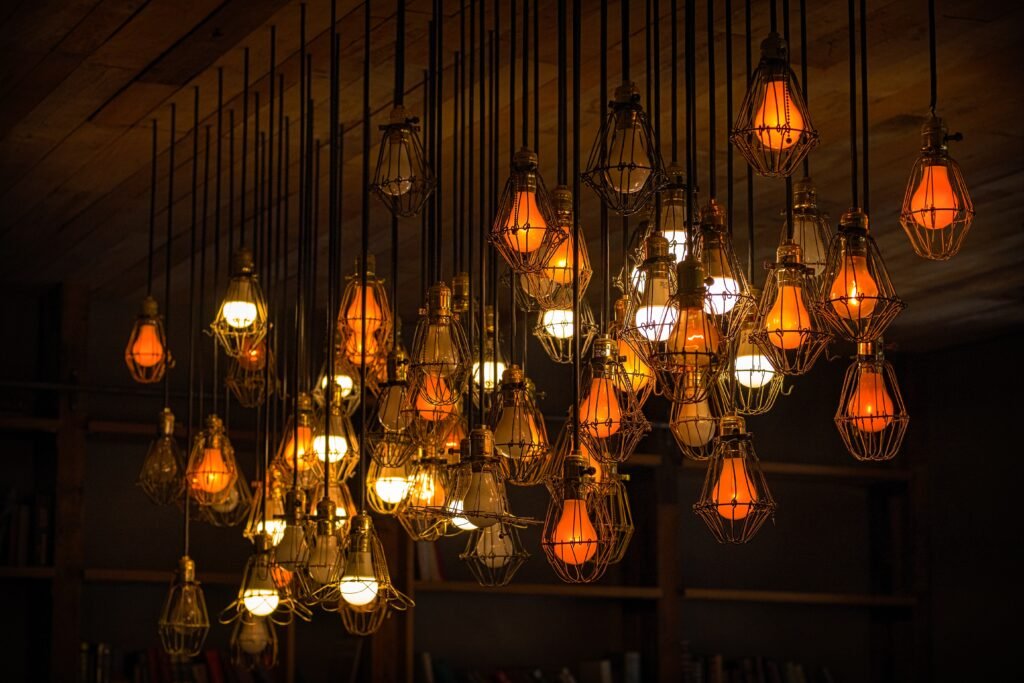Have you ever wondered how smart lighting technology is revolutionizing the way we light up our homes? In this article, we will take a closer look at the latest smart lighting trends that are making waves in the industry. From voice-controlled lighting systems to customizable color options, these innovations are not only enhancing the way we illuminate our spaces but also improving energy efficiency and overall convenience. So, let’s embark on a journey to explore the fascinating world of smart lighting and discover how it can transform your living environment.
Voice Control
Integration with Virtual Assistants
One of the biggest trends in smart lighting today is the integration of voice control with virtual assistants. With the rise in popularity of smart speakers like Amazon Echo and Google Home, more and more people are using voice commands to control their lighting fixtures. This integration allows you to simply speak commands like “turn on the lights” or “dim the living room” and have your lighting system respond instantly. It’s a convenient and hands-free way to control your lights, especially when your hands are full or you’re in another room.
Hands-free Control
With voice control, you can easily adjust your lights without having to physically touch any switches or buttons. This is not only convenient, but also adds an extra layer of hygiene, especially in high-traffic areas like kitchens and bathrooms. Plus, it’s a great solution for individuals with mobility issues or disabilities, as they can easily control the lights with just their voice. Say goodbye to fumbling in the dark or searching for switches – with voice control, your lights are just a voice command away.
Improved Voice Recognition
Thanks to advancements in technology, voice recognition has greatly improved in recent years. Smart lighting systems now have sophisticated algorithms that can detect and decipher voice commands with incredible accuracy. Gone are the days of frustration when your system couldn’t understand what you were saying. Today, smart lighting systems can understand a wide range of accents and dialects, making voice control accessible to a broader range of users. This improved voice recognition technology brings a whole new level of convenience and efficiency to your smart lighting experience.
Energy Efficiency
LED Technology
LED technology has revolutionized the lighting industry, and it continues to be a major trend in smart lighting. LED lights are incredibly energy-efficient, consuming significantly less electricity than traditional incandescent or fluorescent bulbs. They also have a longer lifespan, reducing the need for frequent bulb replacements. By incorporating LED technology into your smart lighting system, you can not only save money on your energy bills but also contribute to a more sustainable future.
Motion and Occupancy Sensors
Another energy-efficient trend in smart lighting is the use of motion and occupancy sensors. These sensors detect when a room is occupied and automatically turn the lights on or off based on movement. This eliminates the need to manually switch lights on and off, saving both time and energy. Motion and occupancy sensors are particularly useful in areas like hallways, closets, and garages, where lights are often left on unintentionally. By installing these sensors, you can ensure that your lights are only in use when they are actually needed.
Daylight Harvesting
Daylight harvesting is a smart lighting technique that takes advantage of natural daylight to reduce energy consumption. By using sensors that measure the amount of natural light in a room, smart lighting systems can automatically adjust the brightness of artificial lights accordingly. If there is ample daylight coming in through the windows, the system will dim the lights or even turn them off completely. This not only saves energy but also creates a more comfortable and pleasant lighting environment. Daylight harvesting is particularly effective in spaces with large windows or skylights, such as offices or living rooms.

Customization and Personalization
Color Temperature
Customization and personalization are key trends in smart lighting, and color temperature is an important aspect of this. Color temperature refers to the warmness or coolness of the light emitted by a bulb. Smart lighting systems allow you to adjust the color temperature of your lights to create different moods or enhance specific activities. For example, you can set a warm, cozy atmosphere in your living room for relaxation, or a cool, bright light in your kitchen for better visibility when cooking. With customizable color temperatures, you have the power to tailor your lighting to fit your personal preferences and needs.
Mood and Scene Lighting
Mood and scene lighting is another exciting trend in smart lighting. With this feature, you can create predefined lighting scenes or presets for different occasions or moods. For example, you can have a “movie night” scene that dims the lights and sets a warm color temperature, or a “party” scene that adds vibrant colors and dynamic lighting effects. These presets can be easily activated with a voice command or through a mobile app, allowing you to instantly transform the ambiance of any space. Whether you want a romantic dinner or a lively gathering, mood and scene lighting give you the flexibility to create the perfect atmosphere.
Individual Fixture Control
Gone are the days of flipping a single light switch and illuminating an entire room. With smart lighting systems, you have the ability to individually control each light fixture. This level of control allows you to adjust the brightness, color, and even direction of light for each fixture, giving you endless possibilities for designing and illuminating your space. You can create unique lighting patterns, highlight specific features or objects, and even create personalized lighting experiences for different members of your household. Individual fixture control is all about putting the power of lighting design in your hands and allowing you to create a truly personalized lighting environment.
Enhanced Security
Presence Simulation
One of the key benefits of smart lighting when it comes to security is the ability to simulate presence even when you’re not home. With the integration of timers and schedules, smart lighting systems can be programmed to turn the lights on and off at specific times, giving the impression that someone is home. This can help deter potential intruders and make your home appear occupied, even when you’re away on vacation or at work. Presence simulation is a simple yet effective way to enhance the security of your home and provide you with peace of mind.
Timers and Schedules
Timers and schedules are powerful features of smart lighting systems that allow you to automate the operation of your lights. You can set specific times for your lights to turn on or off, adjust their brightness, or change their color temperature. This feature not only adds convenience to your daily routine but also helps save energy by ensuring that lights are only in use when needed. For example, you can program your outdoor lights to turn on at dusk and off at dawn, or schedule your bedroom lights to gradually dim down before bedtime. With timers and schedules, you have full control over the timing and operation of your lights.
Integration with Security Systems
Smart lighting can be seamlessly integrated with security systems to create a comprehensive home security solution. By connecting your lighting system to your alarm system or security cameras, you can enhance the effectiveness of both. For example, when an alarm is triggered, the lights can flash or strobe to draw attention to the situation. Similarly, when a security camera detects motion, the lights in that area can automatically turn on to deter intruders. The integration of smart lighting with security systems adds an extra layer of protection to your home and makes your security measures more robust.

Adaptive Lighting
Circadian Rhythm
Adaptive lighting is a cutting-edge trend in smart lighting that aims to align the artificial lighting with our natural circadian rhythm. Our circadian rhythm is the internal biological clock that regulates our sleep-wake cycle and other physiological processes. By mimicking the natural changes in daylight throughout the day, adaptive lighting can help regulate our sleep patterns, improve our mood, and boost our productivity. This is achieved by gradually adjusting the color temperature and brightness of the lights as the day progresses, creating a more harmonious and natural lighting environment.
Tunable White Light
Tunable white light is a feature of smart lighting systems that allows you to dynamically adjust the color temperature of your lights. This means you can have the flexibility to switch between warm, soft light for relaxation and cool, bright light for concentration or tasks that require focus. Tunable white light can be particularly beneficial in spaces like home offices or study areas, where different lighting conditions are needed throughout the day. By tailoring the color temperature to match your needs, you can optimize your lighting environment for maximum comfort and productivity.
Dynamic Light Schedules
Dynamic light schedules are another aspect of adaptive lighting that can greatly enhance your daily routine. Instead of relying on fixed timers and schedules, dynamic light schedules adjust based on external factors such as sunrise and sunset or your personal preferences. For example, as the sun sets, the lights in your living room can gradually dim down to create a more relaxing atmosphere. Similarly, in the morning, the lights in your bedroom can gradually increase in brightness to gently wake you up. Dynamic light schedules take into account the changing natural light throughout the day and adapt your artificial lighting to complement it, creating a more seamless and natural lighting experience.
IoT Integration
Smart Home Integration
The Internet of Things (IoT) is a major driving force behind the evolution of smart lighting. Smart lighting systems can now be seamlessly integrated into larger smart home ecosystems, allowing you to control your lights along with other smart devices in your home. Through a central hub or a mobile app, you can manage not only your lighting but also your thermostats, security systems, entertainment systems, and more. This level of integration provides a unified and streamlined control over your entire smart home, making it easier than ever to manage and customize your living environment.
Interconnectivity with Other Devices
In addition to smart home integration, smart lighting systems can also connect and interact with other devices that are not necessarily part of a smart home ecosystem. For example, you can sync your lights with your music system to create a vibrant light show that matches the rhythm and beats of your favorite songs. Or, you can connect your lights to your fitness tracker and have them change color or brightness based on your activity level or sleep patterns. The interconnectivity of smart lighting with other devices opens up endless possibilities for creative and personalized lighting experiences.
Remote Monitoring and Control
IoT integration also allows for remote monitoring and control of your smart lighting system. With a mobile app or a web portal, you can access and adjust your lights from anywhere in the world, as long as you have an internet connection. This means you can turn your lights on or off, change their color or brightness, or even activate predefined scenes, all with the touch of a button on your smartphone. Remote monitoring and control add a new level of convenience and flexibility to your smart lighting system, enabling you to manage your lights even when you’re not at home.

Human Centric Lighting
Promoting Well-being and Productivity
Human centric lighting is a concept that focuses on enhancing our well-being, health, and productivity through the use of lighting. By considering the biological impact of light on our bodies, smart lighting systems can be designed to provide optimal lighting conditions for different activities and times of the day. For example, during the daytime, the lights can emit cool, bright light to promote alertness and concentration. In the evening, the lights can gradually transition to warmer, softer light to facilitate relaxation and better sleep. Human centric lighting takes into account our natural responses to light and aims to create lighting environments that support our overall well-being and productivity.
Emulating Natural Light
One of the key principles of human centric lighting is emulating natural light. Natural light has a dynamic and ever-changing quality that affects our mood, energy levels, and sleep patterns. By using tunable white light and dynamic light schedules, smart lighting systems can recreate the changing qualities of natural light indoors. This means that the color temperature and brightness of the lights can adjust throughout the day to mimic the natural progression of daylight. Emulating natural light not only enhances our connection with the natural world but also helps regulate our circadian rhythm, leading to improved sleep and overall well-being.
Circadian Lighting
Circadian lighting is a specific application of human centric lighting that focuses on regulating our sleep-wake cycle. Our circadian rhythm is regulated by the presence or absence of blue light, which is abundant in natural daylight. By incorporating blue-enriched light in the morning and gradually reducing it as the day progresses, smart lighting systems can help reset our internal clock and improve our sleep quality. Circadian lighting is especially beneficial for individuals who have irregular sleep patterns, such as shift workers or frequent travelers. By providing the right light at the right time, circadian lighting can help promote a healthier sleep-wake cycle and improve overall sleep hygiene.
Gesture Control
Gesture Recognition Technology
Gesture control is an emerging trend in smart lighting that eliminates the need for physical touch or voice commands. With gesture recognition technology, you can control your lights simply by using hand movements or gestures. For example, a wave of your hand can turn the lights on or off, or a swipe can adjust the brightness or color temperature. Gesture control adds a touch of magic and interactivity to your smart lighting experience, allowing you to control your lights with a simple flick of the wrist.
Intuitive Control
Gesture control offers an intuitive and natural way to interact with your smart lighting system. The gestures required are simple and easy to understand, making it accessible to all users, regardless of their technical knowledge. Whether you’re a tech enthusiast or a novice, gesture control enables you to effortlessly navigate through different lighting settings and modes. This technology truly puts the power of control in your hands, allowing you to shape and sculpt your lighting environment with a simple motion.
Expanding User Interaction
Gesture control not only enhances the user experience but also expands the possibilities for user interaction with smart lighting systems. With gestures, you can trigger predefined lighting scenes or presets, allowing you to instantly transform the ambiance of a room with a flick of the wrist. You can also create custom gestures to activate specific lighting patterns or effects, adding a personal touch to your lighting experience. The introduction of gesture control opens up a whole new world of creativity and expression, enabling you to interact with your lights in a more engaging and immersive way.

Wireless Connectivity
Bluetooth Mesh
Wireless connectivity is an essential aspect of smart lighting, and Bluetooth mesh is a popular protocol in this domain. Bluetooth mesh allows for a network of interconnected devices to communicate with each other and create a robust and reliable wireless network. With Bluetooth mesh, you can control and manage your smart lighting system from a central hub or a mobile app, without the need for complex wiring or additional hardware. This wireless connectivity eliminates the limitations of physical connections and adds flexibility to your smart lighting installation.
Wi-Fi Connectivity
Wi-Fi connectivity is another widely used protocol in smart lighting systems. Wi-Fi allows for seamless integration of your lighting system into your home network, giving you access to control your lights from any connected device. With Wi-Fi connectivity, you can easily manage your lights through a mobile app or a web portal, even when you’re away from home. This level of connectivity provides convenience and accessibility, allowing you to stay connected to your smart lighting system wherever you are.
Zigbee and Z-Wave Protocols
Zigbee and Z-Wave are low-power wireless communication protocols that are commonly used in smart lighting systems. These protocols enable devices to communicate with each other and form a mesh network, creating a reliable and responsive lighting system. Zigbee and Z-Wave are designed specifically for home automation applications and offer enhanced security and energy efficiency compared to other wireless protocols. With Zigbee or Z-Wave connectivity, you can build a robust and scalable smart lighting system that can accommodate a large number of devices and provide seamless control and automation.
Smart Lighting Systems
Centralized Control
Centralized control is a key feature of smart lighting systems that allows you to manage and control all your lights from a single point. Whether it’s through a mobile app, a touch panel, or a voice command, you can adjust the brightness, color, and other settings of all your lights simultaneously. Centralized control offers convenience and simplicity, as you no longer have to go from room to room to manually adjust each light fixture. It also provides a holistic view of your lighting system, allowing you to create synchronized lighting scenes or presets across different areas of your home.
Scalability and Flexibility
Smart lighting systems are highly scalable and flexible, allowing you to easily add or remove lights and expand your system as needed. Whether you’re starting with a single room or outfitting an entire building, smart lighting systems can accommodate any scale of installation. You can start small and gradually add more lights and features over time, or reconfigure your system to adapt to changing needs and preferences. This scalability and flexibility make smart lighting systems a future-proof investment that can grow and evolve with your lifestyle.
Multi-Zone and Zone Control
Smart lighting systems offer the ability to create different lighting zones and control them independently. This means you can group lights in specific areas or rooms and adjust their settings individually or collectively. For example, you can create a “living room” zone and a “kitchen” zone, and have different lighting scenes or presets for each zone. This level of control allows you to tailor the lighting in different areas of your home to match their unique purposes and create personalized lighting experiences. Whether you’re entertaining guests in the living room or cooking in the kitchen, multi-zone and zone control give you the freedom to customize your lighting to suit any occasion.
In conclusion, smart lighting is a rapidly evolving field that offers a wide range of innovative features and capabilities. From voice control and energy efficiency to customization and personalization, smart lighting trends are focused on enhancing convenience, energy savings, and user experience. With the integration of IoT technology, smart lighting systems can now seamlessly connect and interact with other devices, providing a unified and interconnected living environment. As we continue to explore the latest smart lighting trends, it’s clear that the future of lighting is bright, customizable, and full of possibilities.



